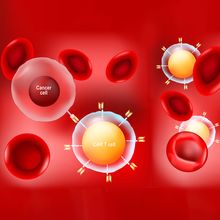Login
Subscribecancer immunology

Interrogating the Complexities of the Tumor Microenvironment
Alison Halliday, PhD, Technology Networks | May 19, 2023 | 5 min read
Gaining a better understanding of the dynamic and reciprocal interactions between cancer cells and the tumor microenvironment is essential for improving patient diagnosis and treatment.

Q&A: What if Immune Cells Don’t Actually Detect Viruses and Bacteria?
Dan Robitzski | Feb 3, 2023 | 10+ min read
The Scientist spoke with Jonathan Kagan about his idea that immune cells respond to “errors” made by unsuccessful pathogens, not the pathogens themselves.

CAR Technology in Cancer Therapy: From CAR-T to CAR-NK
The Scientist’s Creative Services Team and Sino Biological | 4 min read
From early target discovery to preclinical development stages, researchers explore novel strategies for effective cell therapies in cancer treatment.

Why Some HPV Infections Carry More Cervical Cancer Risk
Dan Robitzski | Feb 2, 2023 | 5 min read
Where and how human papillomavirus integrates itself into the human genome steers the infection’s clinical outcomes, finds a large, multifaceted study.

Salmonella Injection Helps the Mouse Immune System Kill Tumors
Dan Robitzski | May 16, 2022 | 3 min read
Nanoparticle-coated bacteria can capture tumor antigens and deliver them to immune cells, triggering a response that improved survival rates in mice.

Shifting Space and Time: How Harnessing Our Most Powerful Cells is Changing Immune Medicine
The Scientist’s Creative Services Team | 1 min read
Industry and academic leaders will describe how small immune cell subsets shape the human immune response.

Infographic: Salmonella Shuttle Tumor Antigens to Immune Cells
Dan Robitzski | May 16, 2022 | 1 min read
Nanoparticle-coated bacteria carry cancer-derived proteins to dendritic cells, enabling the immune system to launch a response in a mouse model.

Traversing Narrow Channels Helps Metastatic Cancer Cells Survive
Dan Robitzski | Apr 14, 2022 | 4 min read
In vitro and mouse experiments show how cancer cells forced through tiny pores—mimicking the physical experience of metastasis—resisted programmed cell death and avoided detection by the immune cells that would normally kill them.

Protein Pilfered from Cancer Cells Thwarts Immune Attack
Dan Robitzski | Apr 13, 2022 | 3 min read
New research in mice reveals why natural killer cells, normally effective at hunting cancer, are sometimes stopped in their tracks.

Book Excerpt from On the Trail of the Jackalope
Michael P. Branch | Feb 14, 2022 | 4 min read
In chapter 8, “Dr. Shope’s Warty Rabbits,” author Michael P. Branch describes the scientist who unearthed the viral cause of strange growths on wild rabbits.

Ten Years On, CAR T Cell Recipient Is Still Cancer-Free
Jef Akst | Feb 3, 2022 | 2 min read
First, the genetically engineered cells became CD8+ killer T cells that wiped out his leukemia. Then they transformed into a stable population of CD4+ helper T cells that continue to circulate in his body.

Modified Salmonella Revs Immune Response, Combats Tumors in Mice
Natalia Mesa, PhD | Feb 3, 2022 | 5 min read
When coated with positively charged particles, the bacteria shuttled antigens out of tumors and activated the immune system, a study finds.

Our Favorite Cancer Stories of 2021
Amanda Heidt | Dec 9, 2021 | 4 min read
This year revealed just how much scientists have learned about the disease, from how animals become naturally cancer-resistant to how tumor cells harness extracellular DNA to develop rapid drug resistance.

Over-the-Counter Antihistamines Could Help Against Cancer
Alejandra Manjarrez, PhD | Nov 24, 2021 | 3 min read
The binding of histamine with one of its receptors within the tumor environment makes cancer cells more resistant to immunotherapy, according to a new study. Blocking that binding could improve responses to treatment.

Cross-Resistance: One Cancer Therapy Can Undermine the Next
Sophie Fessl, PhD | Jul 16, 2021 | 6 min read
Targeted cancer therapy may jeopardize the effectiveness of subsequent immunotherapy by reducing dendritic cell numbers and activation, according to study of mice and patient samples.

Harnessing Stem Cell–Like T Cells to Better Fight Cancer
Daniel E. Speiser and Werner Held | Jul 13, 2020 | 9 min read
Better understanding the CD8+ T cells already present in tumors could be key to making immunotherapies work for more patients.

Miracle Elixirs
Bob Grant | Apr 1, 2019 | 3 min read
A long way into the quest to vanquish cancer, our ears strain to hear the words, “Cancer is cured”—a yearning that can cloud our judgment.

The Next Frontier of CAR T-Cell Therapy: Solid Tumors
Kerry Grens | Apr 1, 2019 | 10+ min read
The technology has wowed the field by all but obliterating some patients’ blood cancers, but solid malignancies present new challenges.

Making CAR T-Cell Therapy Safer
Catherine Offord | Apr 1, 2017 | 8 min read
Following a spate of patient deaths in clinical trials testing modified T cells for the treatment of cancer, researchers work to reduce the treatment’s toxicity without sacrificing efficacy.
